There are relatively few check stamped pottery types that are identified as Florida types. The temper and the rim treatment will be key in identifying each type.
For more detailed information on these and other pottery types within the Southeastern United States, please see our “Publications” page to order Lloyd Schroder’s Field Guide to Southeastern Indian Pottery (Revised & Expanded).
This amazing new book contains over 500 pottery types, each explained in very readable terms with thousands of illustrations and maps of distribution. The volume has earned the acilades of senior archaeologists like David Anderson of the University of Tennessee and well-known Georgia archaeologist Jerald Ledbetter. No serious student of archaeology should be without it.
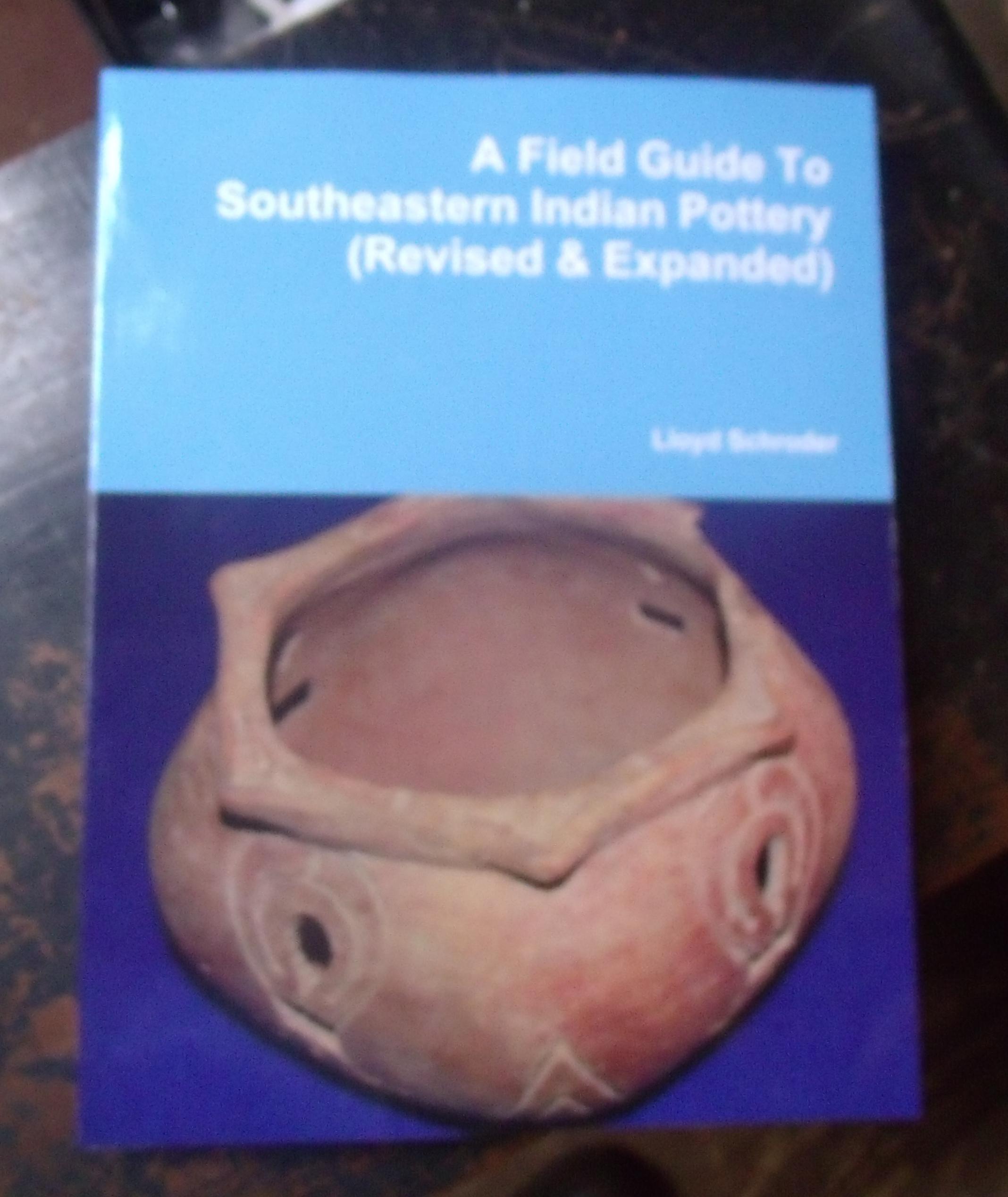
a. Dr. Bob Cramer collection B. Jim Tatum collection
RESEARCH: The type was named by Joseph Caldwell and Antonio Waring in the 1930’s.[i] The name Deptford Bold Check was essentially dropped by the 1960’s. The type was named for the Deptford site in Chatham County, Georgia. This is the same as Cartersville Check Stamped north of Georgia’s Fall Line.
TEMPER: Sand is more often used for temper in Florida and southern Georgia while grit was used elsewhere.
SURFACE DECORATION: The entire surface of the vessel is covered with check stamping. Stamps are generally square or slightly rectangular and clearly stamped. Some stamping was purposely obliterated after stamping.
VESSEL FORMS: Deptford pottery is usually deep, straight-sided jars with rounded or flattened rims. Vessels often have short, stamped tetropodal legs.
CHRONOLOGY: Deptford pottery is part of the Middle Woodland period. Associated points might include spike forms, Woodland Triangular, Baker’s Creek, Yadkin, Copena, Camp Creek, Greenville, and Swan Lake points.
GEOGRAPHIC DISTRIBUTION: Deptford pottery is found over a wide range from the South Carolina Coast across Georgia and parts of eastern Tennessee and eastern Alabama and northern Florida as far south as the Tampa Bay area. North of Georgia’s Fall Line it is known as Cartersville Check Stamped, but the pottery is the same as Deptford pottery.

[i] Williams, Mark. Georgia Indian Pottery web site, University of Georgia
Wayne Porch collection
RESEARCH: Joseph Caldwell and Antonio Waring named this type from their work at the Deptford site in Chatham County, Georgia in 1939.[i]
TEMPER: Sand or grit was used as tempering.
SURFACE DECORATION: Decoration on this type consists of linear check stamping over the entire exterior surface of the vessel. Lines of checks are separated by wide margins to form a “railroad track” appearance.
VESSEL FORMS: Vessels were usually deep, straight-sided jars with rounded or flattened rims. Vessels often have short, podal supports that were also stamped.
CHRONOLOGY: Deptford pottery is part of the Middle Woodland period. Associated points might include spike forms, Woodland Triangular, Baker’s Creek, Yadkin, Copena, Camp Creek, Greenville, and Swan Lake points.
GEOGRAPHIC DISTRIBUTION: Deptford pottery is found over a wide range from the South Carolina coast across Georgia and parts of eastern Tennessee and eastern Alabama and northern Florida as far south as the Tampa Bay area. North of Georgia’s Fall Line it is known as Cartersville Check Stamped, but the pottery is the same as Deptford pottery.
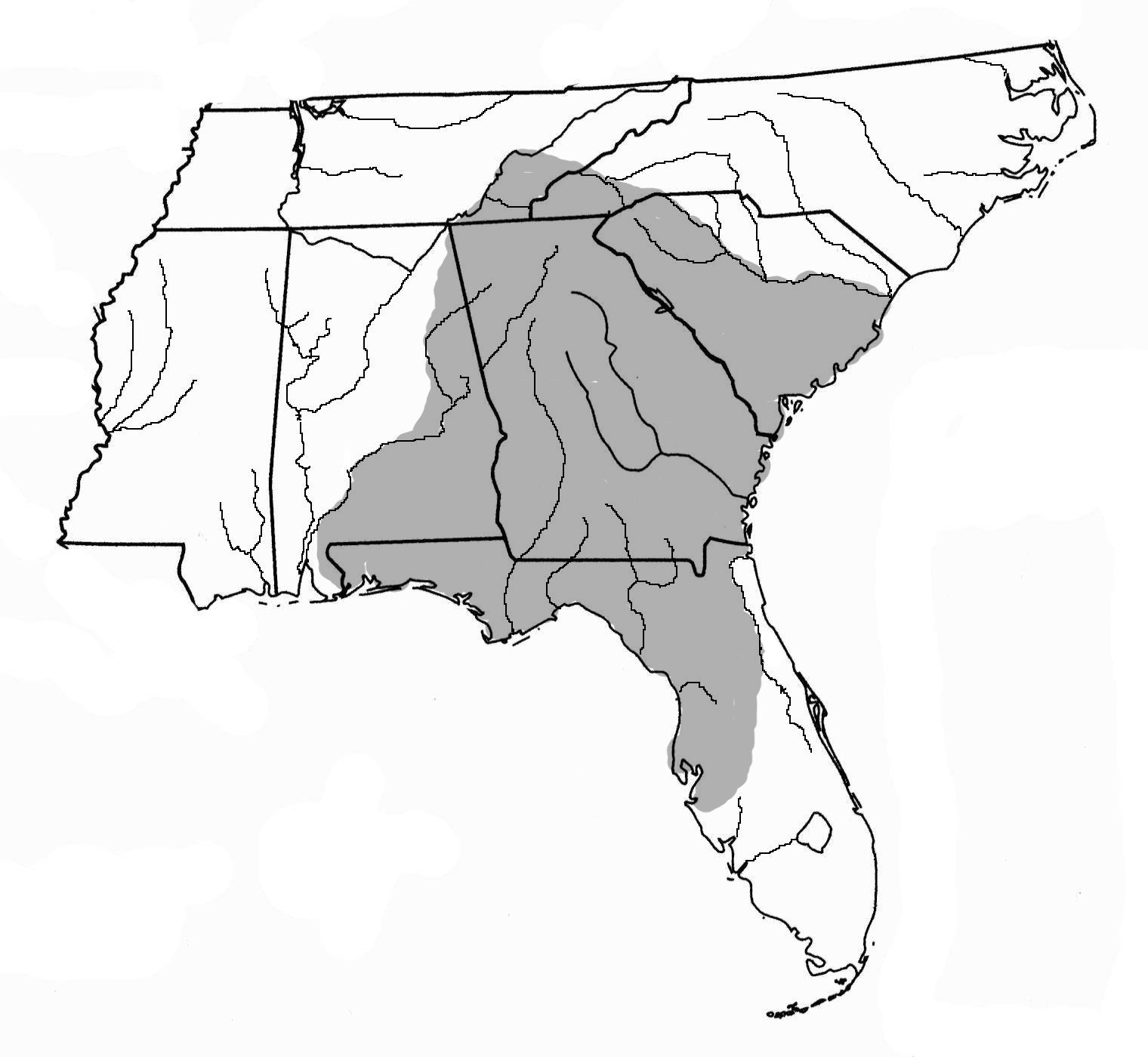
[i] Caldwell, Joseph R., and Antonio J. Waring, Deptford Linear Check Stamped (Southeastern Archaeological Conference, News Letter, vol. 1, no. 5, p.4, Lexington, Ky.)
Gordon R Willey (1949)
RESEARCH: Gordon Willey named this type in 1949.[i] This type name was dropped by SEAC in 1968. Willey’s research stemmed from sites along the Florida Gulf Coast, apparently between St. Andrews and Appalachee Bays. The type is rare and hard to identify.
TEMPER: Fine Sand or mica was used as temper. Much of the sand of these areas has mica present in it, which may account for Willey’s inclusion mica as a tempering agent.
SURFACE DECORATION: Check stamping is carefully done with little over-stamping, more than any other check stamped type in Florida.
VESSEL FORMS: Forms include jars with out-slanting rims and slightly out-flared rims. Lips were rounded or flat and unmodified except for a trifling extrusion of paste on exterior surface; or scallops or notches made by pressing a cylindrical tool onto the top of the lip. Notches or scallops vary from 1 to 5 cm.
CHRONOLOGY: Willey assigned this type to the Middle Woodland, Deptford period and into the Santa Rosa Swift Creek period.. Associated points include Pinellas, Duval, Taylor, and Tallahassee points.
GEOGRAPHIC DISTRIBUTION: The type is found in the Santa Rosa hearth area of the northwest Florida coast between St. Andrews Bay and Appalachee Bay.

[i] Willey, Gordon R., Archaeology of the Florida Gulf Coast, Bureau of American Ethnology Smithsonian Institution, 1949, p.387 Gordon R., Archaeology of the Florida Gulf Coast, Bureau of American Ethnology Smithsonian Institution, 1949, p.429
a. Leon variety b. Fort White variant (the Jefferson check stamped varieties, Leon and Fort White, correspond to Scarry,s Lamar Check Stamped varieties.)
Temper: Grit
Distribution: Spanish mission sites within the Suwannee Valley region
Age: historic period, Spanish mission period
Vessel Form: jars with flaring-rim with a folded and pinched rim.
Decoration: two types are described by Dr. Worth, both of which corresponds to what he named Lamar Check Stamped with the same to named variants. The Leon variety described by Scarry (1985) has diamond shaped checks that are 1 cm or slightly less, and are frequently marked by raised dots in the center, giving the surface a sort of “pineapple” appearance. Stamping ranges from bold and clear to light and indistinct. The Fort White variety is new and quite distinctive. It is characterized by extremely broad checks, generally ranging between 1.5 and 2.1 cm in width. Stamping is uniformly light, and checks are almost perfectly square, with narrow lands.
Lloyd Schroeder collection
RESEARCH: Gordon Willey named this type in 1949.[i] Willey later defined it from sites along the northwestern coast of Florida as Leon Check Stamped. Brent Wiseman later named this type as a sub-type of Jefferson Check Stamped in 1992.[ii] Willey’s research for this type took place in sites along the northwestern Florida coast. Wiseman did his research at the Fig Springs Mission site in Columbus County, Florida.
TEMPER: Sand or course grit was used as temper for this type. The core of the past is black while the fired surface is buff.
SURFACE DECORATION: Impressions of checked stamping can be low and faint while others are deeper and clearer. Stamped designs are also sometimes partially obliterated. The stamped squares are larger than most, averaging 1 cm. square. Stamping may appear as a square or diamond shaped. The vessel rims or collars are sometimes decorated with fingernail punctations.
VESSEL FORMS: Vessels have out-flared rims with round-pointed lips, but the overall form is unknown.
CHRONOLOGY: This pottery belongs to the 17th Century, Leon-Jefferson period. It is found as a minority type in Fort Walton sites in northwestern Florida. Associated points might include Kaskaskia points.
GEOGRAPHIC DISTRIBUTION: The type is found throughout northwest Florida, but it’s range is centered in Leon and Jefferson counties. Occasionally this type is found in the central Gulf Coast region of Florida and also extends into southwestern Georgia.

[i] Willey, Gordon R., Archaeology of the Florida Gulf Coast, Bureau of American Ethnology Smithsonian Institution, 1949, p.491
[ii] Wiseman, Brent, Excavations on the Franciscan Frontier. University Press of Florida, 1992, p.200
Donated by Paleo Enterprises
Look for pits in vessel exterior where limestone particles have leached out (see Pasco Plain).
Temper: Fine to medium limestone particles. Usually smaller than Pasco Plain particles.
Distribution: The southwestern part of the central Florida area may be the hearth of the type, but it also extends out to the central Gulf Coast.
Age: Middle to Late Woodland, Weeden Island I & II periods
Vessel forms: Open and slightly constricted bowls with unmodified rims
Decoration: Check stamping applied with paddle or comparable instrument. Small checks of 3 to 4 mm. and large checks of 6 to 10 mm.
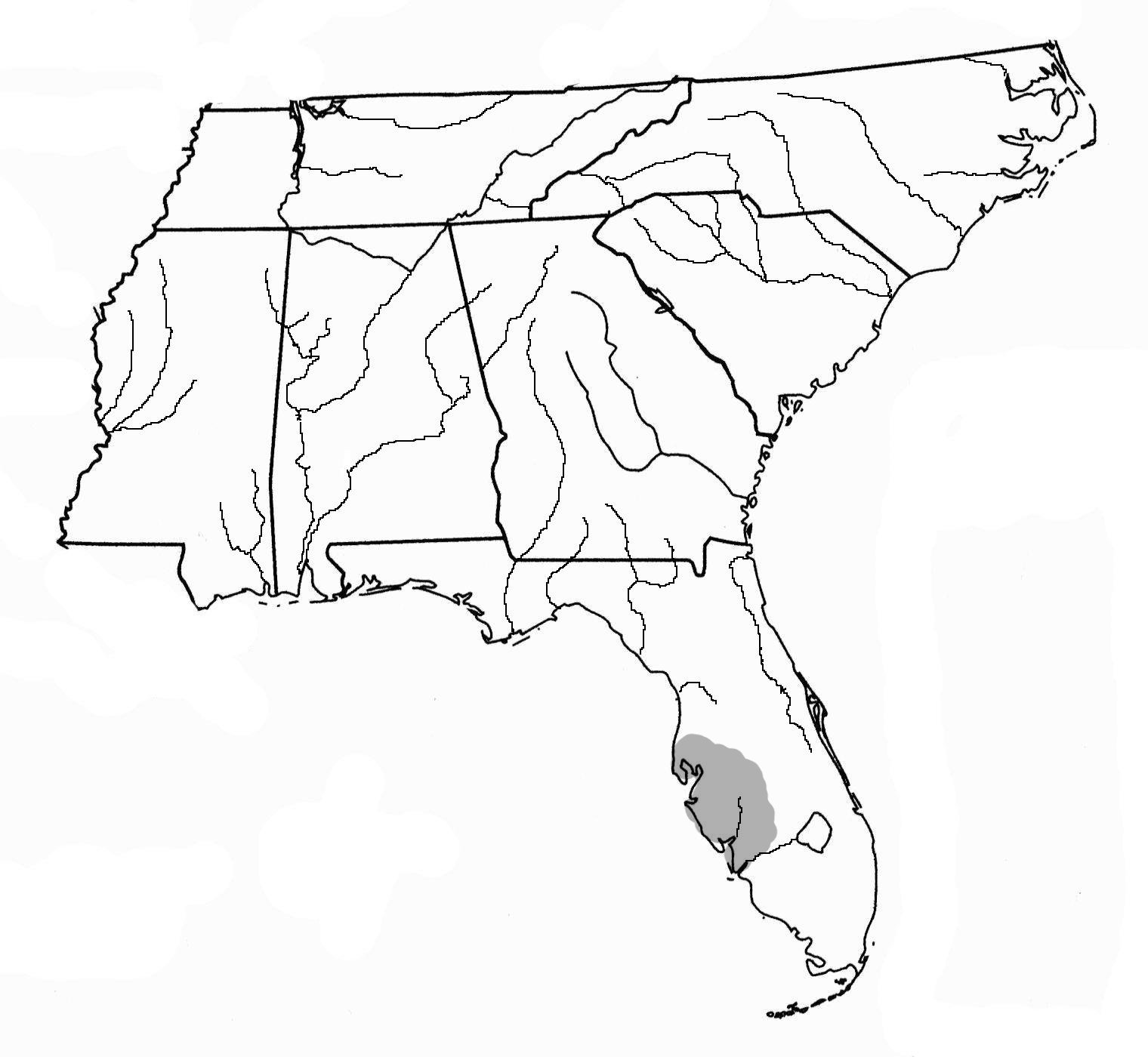
Deagan and Thomas (2009)
RESEARCH: This type was defined by Hale G. Smith in 1948 and commented on by John Goggin in 1952.[i]
TEMPER: John Goggin stated that this type is usually tempered with sand in Florida, but in the area of St. Augustine it may be sand or limestone or a combination of the two. Mark Williams reported that the same material, called Altamaha in Georgia, is tempered with grit.
SURFACE DECORATION: The paddle-made check stamping on this type is fine-lined, small in size and shallow. Vessel exteriors are well smoothed and sometimes painted red. Decoration is sometimes obliterated and often crude. Folded rims are sometimes marked with reed punctations.
VESSEL FORMS: Known vessel forms include large, deep, round-bottom jars with a constricted area below a flaring rim. Spanish “soup plate” forms are also known. A Spanish type ring foot is found on some forms.
CHRONOLOGY: Smith (1948) gives a date of 1686 for simple stamping with other forms of decoration peaking sometime before that period (Goggin). The related point types are brass Kaskaskia points.
GEOGRAPHIC DISTRIBUTION: This type is found in late 17th century mission sites near St. Augustine and northward along the Florida and Georgia coastline. It also occurs in north central Florida and near Tallahassee in the region of the Spanish mission system.
[i] Goggin, John M., Space and Time Perspective in Northern St. Johns Archaeology, Florida, Yale University Press, 1952, p.110
Deagan and Thomas (2009)
RESEARCH: Keith H. Ashley discussed this type among others of the San Pedro series during his further study of the St. Marys Region and related areas of northeastern Florida in 2007.[i] The type is probably named for the mission of San Pedro de Mocama on Cumberland Island in Camden County, Georgia.
TEMPER: This is a pottery type that is tempered with grog or clay (crushed pot sherds) and some sand.
SURFACE DECORATION: Decoration consists of check stamping on paste tempered with crushed sherds and/or sand in the St. Mary’s region early Spanish mission sites. Stamping is most often intentionally smoothed over after stamping.
VESSEL FORMS: While forms are not noted, San Pedro vessels are much heavier or thicker than the St. Marys Cord marked pottery that preceded it.
CHRONOLOGY: This type belongs to the very early Spanish mission period (1560’s to post 1587). The type may have predated Spanish missions as examples were recovered with maze cobs dated to A.D. 1250-1310. Other Florida recoveries in the St. Marys region dated from 1405-1455 and 1490-1640. The related point types are brass Kaskaskia points.
GEOGRAPHIC DISTRIBUTION: San Pedro pottery has also been found in coastal areas and associated inland sites in Camden County, Georgia and Nassau and Duval counties, Florida.

[i] Ashley, Keith H., Straddling the Florida-Georgia State Line Ceramic Chronology of the St. Marys Region (A.D. 1400-1700), From Santa Elena to St. Augustine: Indigenous Ceramic Variability (A.D. 1400-1700), American Museum of Natural History 2009
(Also known as Biscayn Check Stamped in the Tampa Bay area)
Lloyd Schroder collection
RESEARCH: The St. Johns series of pottery was defined by James B. Griffin in 1945 and further commented on by John Goggin in 1952[i] from his work in sites along the St. Johns River, for which this series is named. Goggin’s work continued into the Gulf Coast and southern Florida where Willey later used the name Biscayne ware in 1949.
TEMPER: St. Johns pottery is tempered with diatomaceous earth or soft silky clay that has microscopic fresh water sponge spicules in it that act as temper. The sherds of pottery have a soft, chalky texture, referred to as “chalky ware” as early as 1891, indicating that the ware could be recognized by feel alone. There was an increasing amount of sand in sherds of this type during the late St. Johns II sites.
SURFACE DECORATION: Check stamping on this type usually covered the entire vessel. Execution ranges from neat to sloppy, and from blurred and overlapping. Check sizes are not consistent. Interior sites tend to be earlier and have consistently sized, smaller and neater stamping while coastal sites tend to be later with larger and sloppier stamping. Simple incising often accompanies stamping.
VESSEL FORMS: Vessels are large bowls and some large vessels with conoidal bottoms and out-flaring rims.
CHRONOLOGY: This type appears no earlier than the Late Woodland, St. Johns II period and diminishes during Goggin’s St. Augustine horizon about A.D. 1600. Related point types are Pinellas, Duval, Sarasota, Columbia and Leon points.
GEOGRAPHIC DISTRIBUTION: This type is known primarily from northeastern Florida, but is known in the Tampa Bay and central coast area. It appears in southeastern Georgia as far north as Savannah Georgia and west to Valdosta.

[i] Goggin, John M., Space and Time Perspective in Northern St. Johns Archaeology, Florida, Yale University Press, 1952, p.90-105
Donated by Paleo Enterprises
RESEARCH: The St. Johns series of pottery was defined by John Goggin in 1952[i] from his work in sites along the St. Johns River, for which this series is named, and throughout south Florida where the name Biscayne ware had been used by Willey in 1949.
TEMPER: St. Johns pottery is tempered with diatomaceous earth or soft silky clay that has microscopic fresh water sponge spicules in it that act as temper. The sherds of pottery have a soft, chalky texture, referred to as “chalky ware” as early as 1891, so that the ware can be recognized by feel alone. There was an increasing amount of sand in sherds of this type from late St. Johns II sites.
SURFACE DECORATION: The check stamping on this type is applied over the entire body of the vessel. Rows of checks are laid out with wide parallel lines and crossed with narrower lines or angular crossing lines that form a series of triangles.
VESSEL FORMS: Known forms are large bowls and some large vessels with conoidal bottoms and out-flaring rims.
CHRONOLOGY: This type of St. Johns pottery appeared for a short time during the Middle Woodland, St. Johns Ia period. This time frame is the same as the Englewood and Weeden Island periods, which is the context in which it was recovered from the Englewood Mound. Related point types are Pinellas, Duval, Sarasota, Columbia and Leon points.
GEOGRAPHIC DISTRIBUTION: This type is known from sites throughout peninsular Florida.
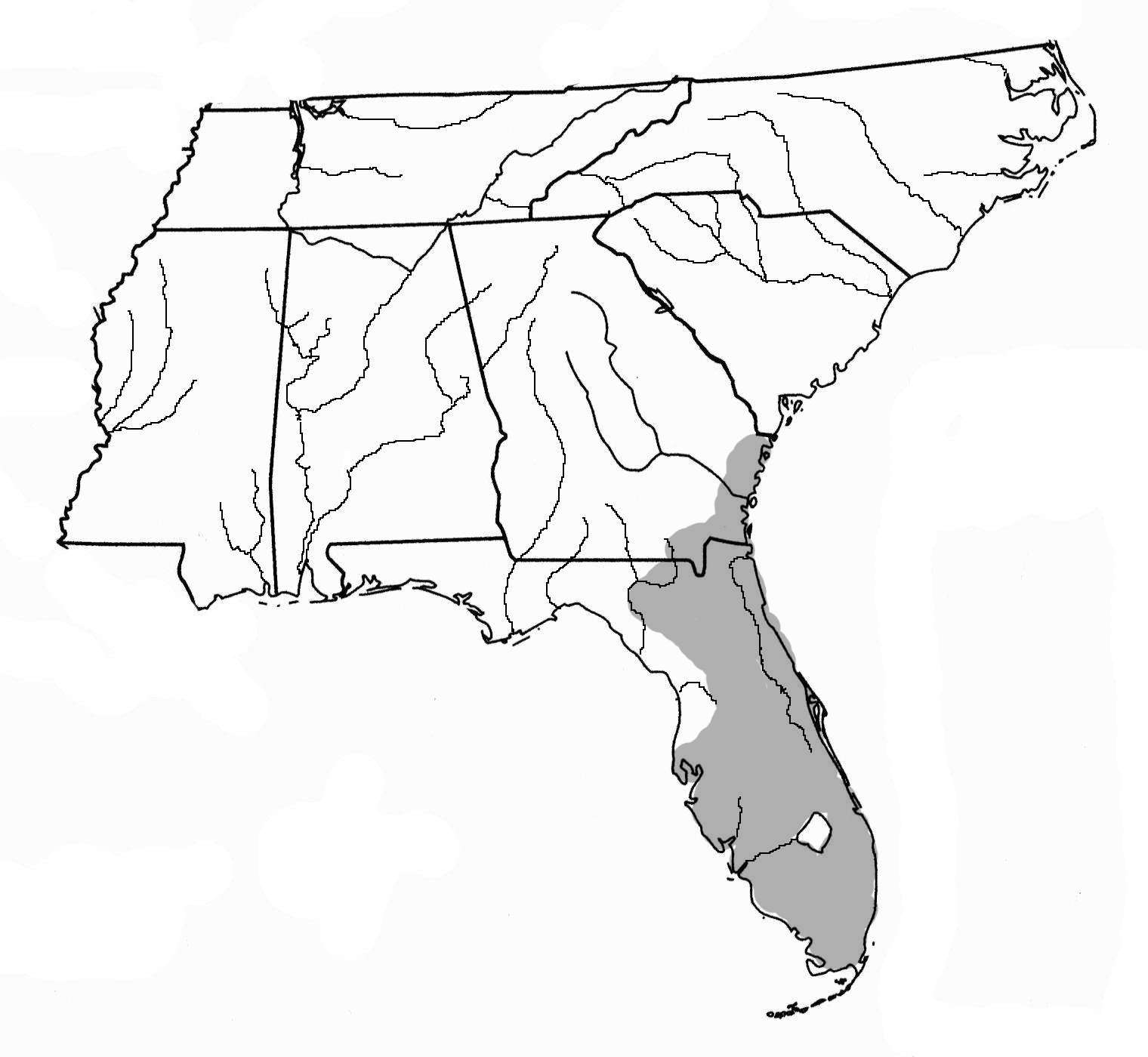
[i] Goggin, John M., Space and Time Perspective in Northern St. Johns Archaeology, Florida, Yale University Press, 1952, p.90-105
a. Lloyd Schroder collection b. donated by Paleo Enterprises
RESEARCH: Gordon Willey defined this type from sites along the Florida Gulf Coast in 1949.[i]
TEMPER: The temper for this type seems to break into three divisions. The first division used fine sand just as the Weeden Island pottery did. The next division used much coarser sand (above right) with a rust or buff exterior. The final division used only a small amount of fine sand or diatomaceous earth (above left) with a modeled buff or gray exterior.
SURFACE DECORATION: Decoration was done with light lands of a check or cross-groove designed paddle. Checks are relatively small and cover the entire surface of the vessel. Folded or simple rims are stamped to the lip of the rim.
VESSEL FORMS: Vessel forms include flattened globular bowls, bowls with incurved rims, deep bowls with out-slanting rims, pots, and jars with long and short collars. Rims are in-curved, out-slanted, straight, slightly inverted or out-slanted. Folded rims are often present.
CHRONOLOGY: This type dates to the Late Woodland, Weeden Island II period. Related point types are Pinellas, Duval, and Leon points.
GEOGRAPHIC DISTRIBUTION: The type occurs in Tampa Bay and sites along the Florida Gulf Coast and up the Chattahoochee River for an unknown distance and into south-central Georgia. Wimberly also encountered it at the James Village site in Clarke County, Alabama.
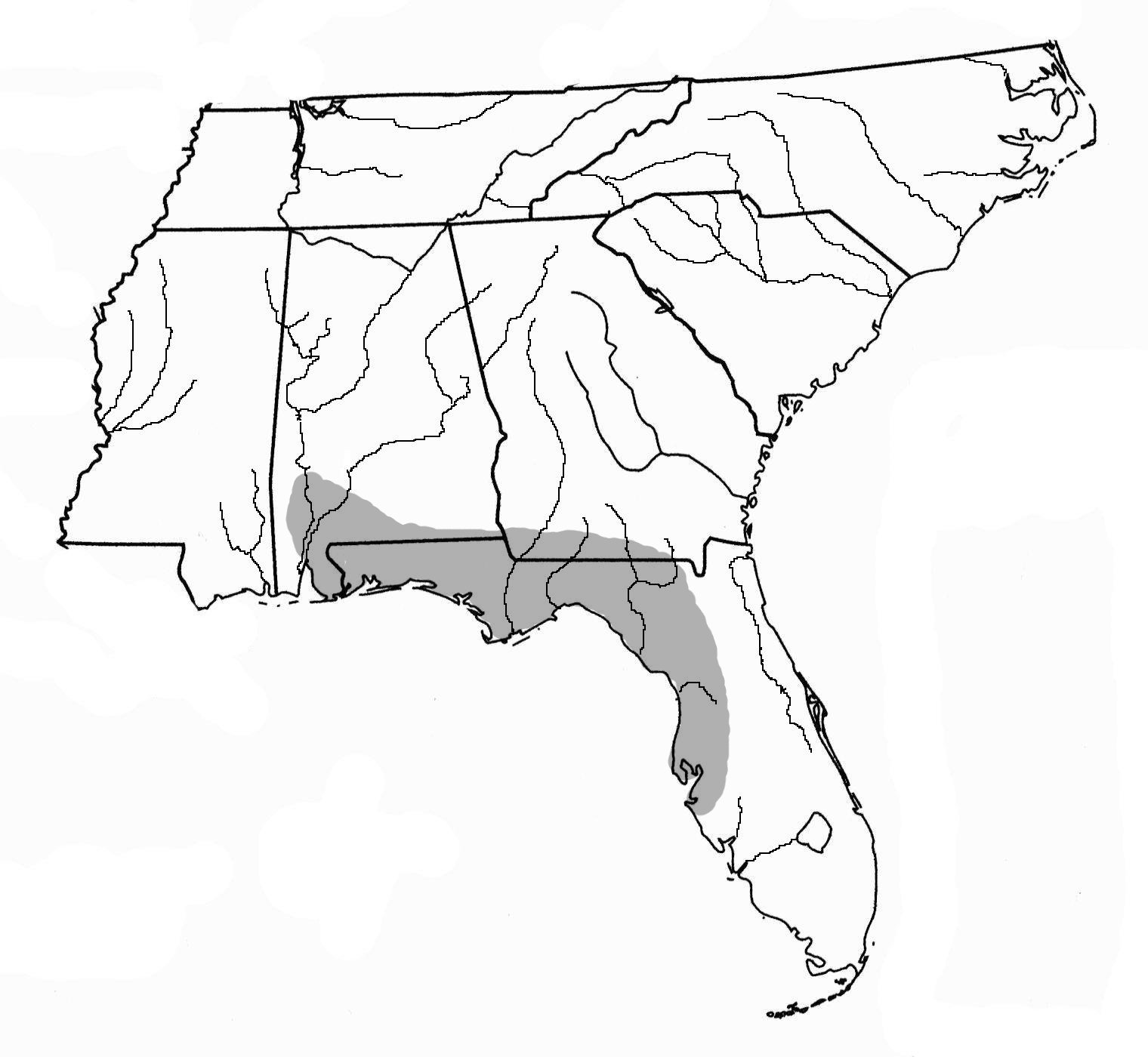
[i] Gordon R., Archaeology of the Florida Gulf Coast, Bureau of American Ethnology Smithsonian Institution, 1949, p. 437